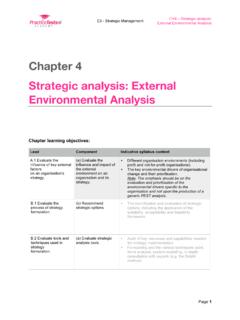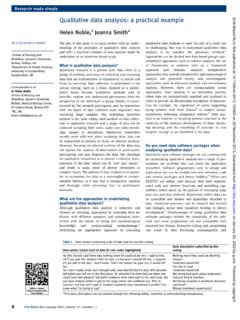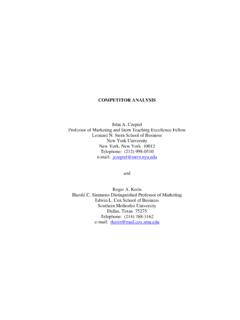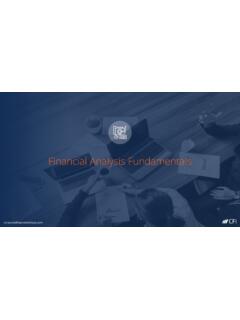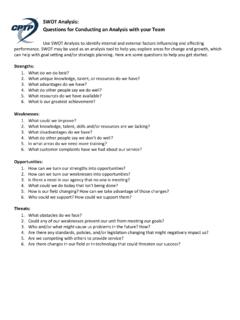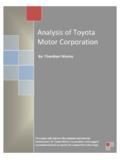Transcription of Machine Learning for Survival Analysis
1 Machine Learning for Survival Analysis Chandan K. Reddy Yan Li Dept. of Computer Science Dept. of Computational Medicine Virginia Tech and Bioinformatics ~reddy Univ. of Michigan, Ann Arbor 1. Tutorial Outline Basic Concepts Statistical Methods Machine Learning Methods Related Topics 2. Tutorial Outline Basic Concepts Statistical Methods Machine Learning Methods Related Topics 3. Healthcare Demographics Comorbodities Laboratory Procedures Medications Age Hypertension Hemoglobin Hemodialysis ACE inhibitor Gender Diabetes Blood count Contrast dye Dopamine Race CKD Glucose Catheterization Milrinone Event IMPACT. Prediction Lower healthcare costs Improve quality of life Model Event of Interest : Rehospitalization; Disease recurrence; Cancer Survival Outcome: Likelihood of hospitalization within t days of discharge 4. Mining Events in Longitudinal Data Classification Problem: 1. 3 +ve and 7 -ve 2. Cannot predict the time of event 3. Need to re-train for each time 4.
2 Subjects 5 6. Regression Problem: Can predict the time of event 7. Only 3 samples (not 10). 8. loss of data 9. 10. - Death 1 2 3 4 5 6 7 8 9 10 11 12 - Dropout/Censored Time Ping Wang, Yan Li, Chandan, K. Reddy, Machine Learning for Survival - Other Events Analysis : A Survey . ACM Computing Surveys (under revision), 2017. 5. Problem Statement For a given instance , represented by a triplet , , . is the feature vector;. is the binary event indicator, , 1 for an uncensored instance and 0 for a censored instance;. denotes the observed time and is equal to the Survival time for an uncensored instance and for a censored instance, , 1. 0. Note for : The value of will be both non-negative and continuous. is latent for censored instances. Goal of Survival Analysis : To estimate the time to the event of interest for a new instance with feature predictors denoted by . 6. Education Demographics Financial Pre-enrollment Enrollment Semester Age Cash amount High school GPA Transfer credits Semester GPA.
3 Gender Income ACT scores College % passed Race/Ethnicity Scholarships Graduation age Major % dropped IMPACT. Event Educated Society Prediction Better Future Model Event of Interest : Student dropout Outcome: Likelihood of a student being dropout within t days S. Ameri, M. J. Fard, R. B. Chinnam and C. K. Reddy, " Survival Analysis based Framework for Early Prediction of Student Dropouts", CIKM 2016. 7. Crowdfunding Projects Creators Twitter Temporal Duration Past success # Promotions # Backers Goal amount Location Backings Funding Category # projects Communities # retweets Event IMPACT. Improve local economy Prediction Successful businesses Model Event of Interest: Project Success Outcome: Likelihood of a project being successful within t days Y. Li, V. Rakesh, and C. K. Reddy, "Project Success Prediction in Crowdfunding Environments", WSDM 2016. 8. Other Applications Reliability: Device Failure Modeling in Engineering Goal: Estimate when a device will fail Features: Product and manufacturer details, user reviews Duration Modeling: Unemployment Duration in Economics Goal: Estimate the time people spend without a job (for getting a new job).
4 Features: User demographics and experience, Job details and economics Click Through Rate: Computational Advertising on the Web Goal: Estimate when a web user will click the link of the ad. Features: User and Ad information, website statistics Customer Lifetime Value: Targeted Marketing Goal: Estimate the frequent purchase pattern for customers. Features: Customer and store/product information. How long ? History information Event of interest 9. Taxonomy of Survival Analysis Methods Kaplan-Meier Basic Cox-PH Lasso-Cox Statistical Methods Non-Parametric Nelson-Aalen Penalized Cox Ridge-Cox Time-Dependent EN-Cox Life-Table Cox OSCAR-Cox Semi-Parametric Cox Regression Cox Boost Linear Regression Tobit Weighted Parametric Buckley James Regression Accelerated Panelized Structured Failure Time Regression Regularization Survival Trees Na ve Bayes Survival Analysis Bayesian Methods Methods Bayesian Network Neural Network Random Survival Forests Machine Support Vector Bagging Survival Learning Machine Trees Ensemble Active Learning Transfer Advanced Machine Learning Learning Multi-Task Learning Uncensoring Early Prediction Data Calibration Related Topics Transformation competing Risks Complex Events Recurrent Events 10.
5 Tutorial Outline Basic Concepts Statistical Methods Machine Learning Methods Related Topics 11. Basics of Survival Analysis Main focuses is on time to event data. Typically, Survival data are not fully observed, but rather are censored. Several important functions: Death Survival function, indicating the probability that the stance instance can survive for longer than a certain time t. Pr Cumulative density function, representing the probability that the event of interest occurs earlier than t. Survival function 1 exp Death density function: . Hazard function: representing the probability the event of interest occurs in the next instant, given Survival to time t. ln Cumulative hazard function Chandan K. Reddy and Yan Li, "A Review of Clinical Prediction Models", in Healthcare Data Analytics, Chandan K. Reddy and Charu C. Aggarwal (eds.), Chapman and Hall/CRC Press, 2015. 12. Evaluation Metrics Due to the presence of the censoring in Survival data, the standard evaluation metrics for regression such as root of mean squared error and are not suitable for measuring the performance in Survival Analysis .
6 Three specialized evaluation metrics for Survival Analysis : Concordance index (C-index). Brier score Mean absolute error 13. Concordance Index (C Index). It is a rank order statistic for predictions against true outcomes and is defined as the ratio of the concordant pairs to the total comparable pairs. Given the comparable instance pair , with and are the actual observed times and S( ) and S( ) are the predicted Survival times, The pair , is concordant if > and S( ) > S( ). The pair , is discordant if > and S( ) < S( ). Then, the concordance probability Pr measures the concordance between the rankings of actual values and predicted values. For a binary outcome, C-index is identical to the area under the ROC curve (AUC). U. Hajime, et al. "On the C statistics for evaluating overall adequacy of risk prediction procedures with censored Survival data." Statistics in medicine, 2011. 14. Comparable Pairs The Survival times of two instances can be compared if: Both of them are uncensored.
7 The observed event time of the uncensored instance is smaller than the censoring time of the censored instance. Without Censoring With Censoring A total of 5C2 comparable pairs Comparable only with events and with those censored after the events H. Steck, B. Krishnapuram, C. Dehing-oberije, P. Lambin, and V. C. Raykar, On ranking in Survival Analysis : Bounds on the concordance index , NIPS 2008. 15. C index When the output of the model is the prediction of Survival time: 1. |. : : Where | is the predicted Survival probabilities, denotes the total number of comparable pairs. When the output of the model is the hazard ratio (Cox model): 1.. : : Where is the indicator function and is the estimated parameters from the Cox based models. (The patient who has a longer Survival time should have a smaller hazard ratio). 16. C index during a Time Period Area under the ROC curves (AUC) is 1. 0, 1. In a possible Survival time , is the set of all possible Survival times, the time-specific AUC is defined as 1.
8 , : : denotes the number of comparable pairs at time . Then the C-index during a time period 0, can be calculated as: : .. C-index is a weighted average of the area under time-specific ROC. curves (Time-dependent AUC). 17. Brier Score Brier score is used to evaluate the prediction models where the outcome to be predicted is either binary or categorical in nature. The individual contributions to the empirical Brier score are reweighted based on the censoring information: 1. denotes the weight for the instance. The weights can be estimated by considering the Kaplan-Meier estimator of the censoring distribution on the dataset. /. 1/. The weights for the instances that are censored before will be 0. The weights for the instances that are uncensored at are greater than 1. E. Graf, C. Schmoor, W. Sauerbrei, and M. Schumacher, Assessment and comparison of prognostic classification schemes for Survival data , Statistics in medicine, 1999. 18. Mean Absolute Error For Survival Analysis problems, the mean absolute error (MAE).
9 Can be defined as an average of the differences between the predicted time values and the actual observation time values. 1. | |. where -- the actual observation times. -- the predicted times. Only the samples for which the event occurs are being considered in this metric. Condition: MAE can only be used for the evaluation of Survival models which can provide the event time as the predicted target value. 19. Summary of Statistical methods Type Advantages Disadvantages Specific methods More efficient when no Difficult to interpret; Kaplan-Meier Non- suitable theoretical yields inaccurate Nelson-Aalen parametric distributions known. estimates. Life-Table Cox model The knowledge of the The distribution of the Regularized Cox Semi- underlying distribution of outcome is unknown;. parametric Survival times is not CoxBoost not easy to interpret. required. Time-Dependent Cox Easy to interpret, more When the distribution Tobit efficient and accurate assumption is violated, it Buckley-James Parametric when the Survival times may be inconsistent and follow a particular can give sub-optimal Penalized regression distribution.
10 Results. Accelerated Failure Time 20. Kaplan Meier Analysis Kaplan-Meier (KM) Analysis is a nonparametric approach to Survival outcomes. The Survival function is: 1. : where -- a set of distinct event times observed in the sample. -- number of events at . -- number of censored observations between and . -- number of individuals at risk right before the death. E. Bradley. "Logistic regression, Survival Analysis , and the Kaplan-Meier curve." JASA 1988. 21. Survival Outcomes Patient Days Status Patient Days Status Patient Days Status Status 1 21 1 15 256 2 29 398 1. 1: Death 2 39 1 16 260 1 30 414 1 2: Lost to follow up 3 77 1 17 261 1 31 420 1 3: Withdrawn Alive 4 133 1 18 266 1 32 468 2. 5 141 2 19 269 1 33 483 1. 6 152 1 20 287 3 34 489 1. 7 153 1 21 295 1 35 505 1. 8 161 1 22 308 1 36 539 1. 9 179 1 23 311 1 37 565 3. 10 184 1 24 321 2 38 618 1. 11 197 1 25 326 1 39 793 1. 12 199 1 26 355 1 40 794 1. 13 214 1 27 361 1. 14 228 1 28 374 1. 22. Kaplan Meier Analysis Kaplan-Meier Analysis Time Status 1 21 1 1 0 40 2 39 1 1 0 39 3 77 1 1 0 38 4 133 1 1 0 37 5 141 2 0 1 36.


